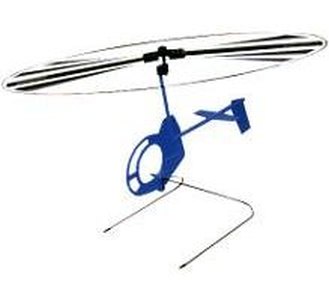- Home Page
- Kiddy Kites
- Helicopter Kite
The Helicopter Kite
Unusual, But It Flies!
The helicopter kite operates on the same principle as a gyrocopter. It's something different! A large rotor is kept spinning by the airflow across it, like a fan being blown in the wind. Once spinning, the rotor develops lift like a wing and can lift the rest of the kite.
A small tail-fin keeps the kite pointing into wind, like the tail does for a diamond kite. Also, a small horizontal stabilizer at the back helps keep the rotor blade at the correct nose-up angle to the wind.
As far as my own flying products go, I never did tackle a heli. It's a bit hard to do in dowel and plastic sheet—or paper ;-)
On this site, there's more kite-making info than you can poke a stick at :-)
Want to know the most convenient way of using it all?
The Big MBK E-book Bundle is a collection of downloads—printable PDF files which provide step-by-step instructions for many kites large and small.
Every kite in every MBK series.
The Helicopter Kite as a Toy
The most well-known product (and perhaps one of very few of this type) was manufactured in and distributed worldwide from a single location in the USA. Besides Helicopter Kite, this toy also popped up under other names:
 Hard plastic helicopter kite
Hard plastic helicopter kite- Gyro-Kite
- SkyChopper
- WindCopter
- CopterKite
- GyroCopter
- CobraKite
All these products were essentially the same, with the differences being mainly in the packaging. The kite required some assembly, but it was just a few simple plug-it-in operations as far as I could see.
I've seen videos of this toy in flight and it appeared reliable and stable. However, it would never reach the line angles of a good delta kite! Having said that, I still think it would have been something of a head-turner for the kids down in the local park. My boy would have loved one when he was quite young, I'm sure.
Helicopter Kites in History
Apart from children's toys, some man-carrying craft of this type can be found in history. I should mention a distinction here. The gyrocopter concept can fly
- as a powered craft with a propulsion unit attached
- tethered—like a kite
Now let's look at both of these in turn.
Apparently the powered gyrocopter concept has been around since the 1920s. A motor would spin a pusher-prop, giving forward speed, while the free-spinning rotor above would support the weight of the craft. When improvements in helicopters made them practical, autogyros, as the free-spinning versions were often called, faded in popularity.
Autogyros were, however, used in the 1930s by major newspapers. Also, the US Postal Service used autogyros for a couple of mail-service routes. One of these routes ended up on the roof of a large building, which says something about the slow-speed capabilities of these machines.
But here's something very interesting—autogyros have made a comeback of sorts! They are now yet another type of sport aircraft.
In World War II, Germany developed a tiny gyrocopter kite, the
Focke-Achgelis Fa 330. This machine was towed by U-boats for aerial
surveillance. Later, the Japanese Army developed the Kayaba Ka-1
Autogyro for reconnaissance, artillery-spotting, and anti-submarine
warfare.
So it's a saga that began with war machinery and has ended up in the children's-toys department!
As mentioned earlier, there's more kite making on this site than you can poke a stick at. :-)
Want to know the most convenient way of using it all?
The Big MBK E-book Bundle is a collection of downloads—printable PDF files that provide step-by-step instructions for many kites large and small.
That's every kite in every MBK series.
